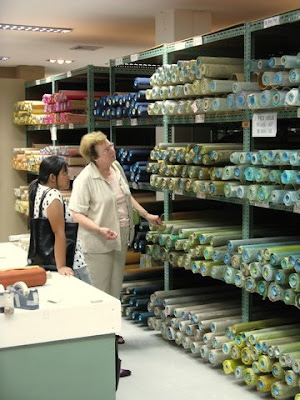
Well, with New Year's Day upon us today I put up the banner I made to celebrate the New Year Japanese-style. The New Year celebration in Japan is a really big deal, complete housecleaning and lots of traditional decorations, visits, gifts etc. Many of these contain what are called "shochikubai" the trio of pine, bamboo and plum blossom. The literal translation is "the three friends of winter". The notion originated, as many of these things do, in China. The convention is that pine and bamboo stay green throughout the winter and plum blossoms open while it is still winter also. You see these three grouped together over and over in Japanese textiles and the variety is endless.
Here is the banner I made. The stencil is quite large and comes from a family crest design. I used it on a big indigo noren but have no room for it so this more delicate one hangs in my entry awaiting a proper tassel on the bottom.
I found a set of postcards in Japan that were done by my favorite katazome artist of all time. I cannot read his name but I have seen his work in books and calendars before. This little Kyoto scene depicts a multi panel noren with the same trio of images. I adore the delicacy of his shading.

The variety of ways of depicting bamboo are fairly predictable and plum blossoms too (always five rounded petals with a starry center, and often budded branches), but when it comes to pines the sky is the limit. Here is a set of small examples:

While pine trees may be depicted fairly realistically as in the image on the upper left, often they become so stylized, as on the lower right that they are hardly recognizable as pine trees. I have several stencils like this that I use for indigo. Pine bark is often depicted with a series of jagged diamond shapes, frequently filled with other images (see upper right). Pine needles are pretty done as radiating sprays as in lower left, but you often see the needles scattered by themselves. Japanese pine needles always come two to a bundle so they have come to represent long marriages. (They can be almost infinitesimally tiny when used on kimonos for old married ladies, who traditionally wore increasingly small patterns and muted colors as they aged.)
I have an antique stencil that I used to make an indigo piece, ( so when I travel to teach I will have a less fragile example for my students). See how the plum blossom shapes have been used to contain other more detailed members of the trio.

The final piece I will share is one of the first quilts I ever made. It takes the form of a Buddhist monks robe, a kesa. It is pieced in sashed columns in a pattern known as rice paddy. The more columns, the more important the monk. The Buddha wore rags, but the monks robes, although pieced to represent rags , were often made of really sumptuous fabrics. Some of the first complex cloth I made was much too pretty to cut up so I used every scrap to make this quilt. The elements are pine branches, with bamboo in the sashing and plum blossoms for the square pieces in center and corners. Hence it had to be called "The Three Friends Kesa".






















































